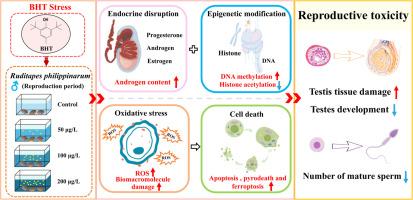Mechanism of reproductive toxicity of BHT on male Ruditapes philippinarum: epigenetic - testis development and oxidative damage - cell death
IF 4.3
2区 环境科学与生态学
Q1 MARINE & FRESHWATER BIOLOGY
引用次数: 0
Abstract
Synthetic phenolic antioxidants (SPAs) are widely utilized in industrial production and consumer goods owing to their excellent antioxidant properties. However, their potential for multiple toxic effects, coupled with the increasing levels of environmental pollution, has heightened public concern. Currently, there is a relative scarcity of study on the reproductive toxicology of SPAs in hydrobios, with a particular dearth of studies in invertebrates. This study investigates the reproductive toxicity of the typical SPAs butylhydroxytoluene (BHT) in male clams Ruditapes philippinarum across distinct breeding period. The finding show that,the processes of meiosis and spermatogenesis were inhibited, leading to a decreased number of mature sperm and a reduced gonad index. Furthermore, an increase in reactive oxygen species (ROS) content was observed in the testes under BHT stress, causing biomacromolecular damage. BHT induces different types of cell death processes in testis cells, thereby damaging sperm development.Ultimately, this investigation clarifies the molecular basis for reproductive toxicity caused by BHT in invertebrates living in water. The research specifically analyzed contributing factors including endocrine disruption, epigenetic effects, and oxidative stress. The experimental results provide valuable data support for marine shellfish germplasm conservation and marine SPAs pollution detection.

BHT对雄性菲律宾绒螯蟹生殖毒性的机制:表观遗传-睾丸发育和氧化损伤-细胞死亡
合成酚类抗氧化剂因其优异的抗氧化性能在工业生产和消费品中得到了广泛的应用。然而,它们潜在的多重毒性作用,加上日益严重的环境污染,引起了公众的高度关注。目前,对水生生物中spa的生殖毒理学研究相对较少,特别是对无脊椎动物的研究较少。本研究探讨了不同繁殖期雄性菲律宾蛤(Ruditapes philippinarum)中典型SPAs丁基羟基甲苯(butylhydroxytoluene, BHT)的生殖毒性。结果表明,减数分裂和精子发生过程受到抑制,导致成熟精子数量减少,性腺指数降低。在BHT胁迫下,睾丸中活性氧(ROS)含量增加,造成生物大分子损伤。BHT在睾丸细胞中诱导不同类型的细胞死亡过程,从而损害精子发育。最终,本研究阐明了BHT对水中无脊椎动物生殖毒性的分子基础。该研究特别分析了包括内分泌干扰、表观遗传效应和氧化应激在内的影响因素。实验结果为海洋贝类种质资源保护和海洋spa污染检测提供了有价值的数据支持。
本文章由计算机程序翻译,如有差异,请以英文原文为准。
求助全文
约1分钟内获得全文
求助全文
来源期刊

Aquatic Toxicology
环境科学-毒理学
CiteScore
7.10
自引率
4.40%
发文量
250
审稿时长
56 days
期刊介绍:
Aquatic Toxicology publishes significant contributions that increase the understanding of the impact of harmful substances (including natural and synthetic chemicals) on aquatic organisms and ecosystems.
Aquatic Toxicology considers both laboratory and field studies with a focus on marine/ freshwater environments. We strive to attract high quality original scientific papers, critical reviews and expert opinion papers in the following areas: Effects of harmful substances on molecular, cellular, sub-organismal, organismal, population, community, and ecosystem level; Toxic Mechanisms; Genetic disturbances, transgenerational effects, behavioral and adaptive responses; Impacts of harmful substances on structure, function of and services provided by aquatic ecosystems; Mixture toxicity assessment; Statistical approaches to predict exposure to and hazards of contaminants
The journal also considers manuscripts in other areas, such as the development of innovative concepts, approaches, and methodologies, which promote the wider application of toxicological datasets to the protection of aquatic environments and inform ecological risk assessments and decision making by relevant authorities.
 求助内容:
求助内容: 应助结果提醒方式:
应助结果提醒方式:


